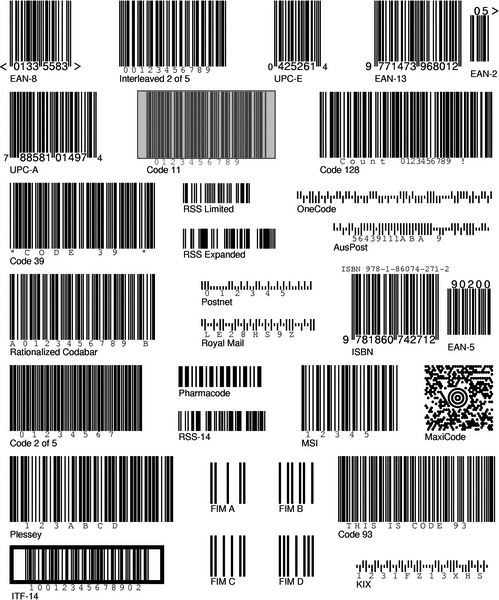Sort by Shape

Industry Standards for Barcodes and Labels
- Bookland EAN encodes ISBN numbers, used internationally to mark books
- ISSN and the SISAC Barcode: International Standard Serial Numbering
- OPC: Optical Industry Associationbarcode for marking retail optical products
- UCC/EAN-128: Widely used data formatting model for Code 128
- UPC Shipping Container Symbol: ITF-14
- Co-Operative labels: Located under software
Alphanumeric barcodes
- Code 39: General-purpose code in very wide use world-wide
- Code 93: Compact code similar to Code 39
- Code 128: Very capable code, excellent density, high reliability; in very wide use world-wide
- LOGMARS: Same as Code 39, this is the U.S. Government specification
Numeric-only barcodes
- EAN-13: European Article Numbering international retail product code
- EAN-8: Compressed version of EAN code for use on small products
- UPC-A: Universal product code seen on almost all retail products in the USA and Canada
- UPC-E: Compressed version of UPC code for use on small products
- Code 11: Used primarily for labeling telecommunications equipment
- Interleaved 2 of 5: Compact numeric code, widely used in industry, air cargo, other applications
- Industrial 2 of 5: Older code not in common use
- Standard 2 of 5: Older code not in common use
- Codabar: Older code often used in library systems, sometimes in blood banks
- Plessey: Older code commonly used for retail shelf marking
- MSI: Variation of the Plessey code commonly used in USA
- PostNet: Used by U.S. Postal Service for automated mail sorting
2-Dimensional barcodes
- PDF417: Excellent for encoding large amounts of data
- DataMatrix: Can hold large amounts of data, especially suited for making very small codes
- Maxicode: Fixed length, used by United Parcel Service for automated package sorting
- QR Code: Used for material control and order confirmation
- Data Code
- Code 49
- 16K







